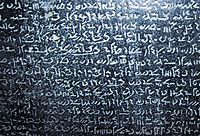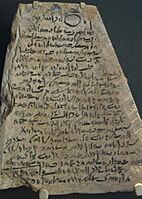Demotic (Egyptian) facts for kids
Quick facts for kids Demotic |
|
|---|---|

Demotic script on a Rosetta Stone replica
|
|
| Type | Logographic with consonants |
| Spoken languages | Egyptian language (Demotic) |
| Time period | c. 650 BC – 5th century AD |
| Parent systems |
Egyptian hieroglyphs
|
| Child systems | Meroitic, Coptic (influenced) |
| ISO 15924 | Egyd |
| Note: This page may contain IPA phonetic symbols in Unicode. | |
Demotic is an ancient Egyptian writing system. Its name comes from a Greek word meaning 'popular'. This script developed from an earlier form of Egyptian writing called hieratic. It was mainly used in the northern part of ancient Egypt, especially in the Nile Delta area.
The Greek historian Herodotus was the first to use the name "Demotic". He used it to tell this script apart from hieratic and hieroglyphic writing. When you see the word "Demotic" capitalized, it refers to this ancient Egyptian script. This helps avoid confusion with "demotic Greek," which is a different language.
Contents
Understanding the Demotic Script
The ancient Egyptians themselves called the Demotic script 'document writing'. This name shows that it was often used for everyday papers. Early European experts sometimes called it "Enchorial Egyptian."
Demotic was used for over a thousand years. During this long time, it changed and developed in several ways. Unlike some older hieroglyphs, Demotic was always written and read from right to left. Some parts of ancient magical texts, called the Greek Magical Papyri, even used a secret code with Demotic!
Early Demotic: The Beginning
Early Demotic started in Lower Egypt around 650 to 400 BC. You can find examples of it on stone slabs, called steles, from places like the Serapeum of Saqqara. This period includes the Twenty-sixth Dynasty and when Egypt was part of the Achaemenid Empire.
When Egypt was reunited under Psamtik I, Demotic became very important. It replaced another script in Upper Egypt and became the official writing for government and legal papers. At this time, Demotic was used for business and law. Hieroglyphs and hieratic were still used for religious texts and stories.
Middle Demotic: A Time of Change
Middle Demotic was used from about 400 to 30 BC, during the Ptolemaic Kingdom. During this time, Demotic became more important for writing stories and religious texts.
However, by the end of the 3rd century BC, Koine Greek became the main language for government in Egypt. This meant that Demotic contracts were not as legally strong unless they were also registered in Greek.
- Examples of Ptolemaic Demotic
-
Ostracon with Demotic inscription. This is a piece of pottery with writing on it. It's a prayer to the god Amun to heal a man's blindness.
Late Demotic: Fading Away
When the Romans took over Egypt, Demotic was used less and less in public life. Still, some literary texts were written in Late Demotic from about 30 BC to 452 AD. Most of these were from the 1st and 2nd centuries AD.
Unlike what happened in other parts of the Roman Empire where Latin completely replaced local languages, Greek did not fully replace Demotic in Egypt. After the 2nd century, Demotic was only used for small notes, labels on mummies, and drawings on temple walls. The very last known example of Demotic writing is a drawing on a temple wall at Philae. It is dated December 12, 452 AD, and simply says, "Petise, son of Petosiris."
How Demotic Signs Work
Like the older hieroglyphs, Demotic had "uniliteral" signs. These are like letters in an alphabet, each representing a single sound. These single-sound signs were very common in Demotic texts. They made up about one-third to one-half of all the signs in any text. Foreign words were almost always written using these signs. Later texts from the Roman period used these signs even more often.
The table below shows some of these single-sound signs. It also shows their original hieroglyphic form and how they relate to Coptic letters, which came later.
Deciphering Demotic: The Rosetta Stone
The Rosetta Stone was found in 1799. It is a famous stone with the same message written in three different scripts. These scripts are Egyptian hieroglyphs, Demotic, and the Greek alphabet. The Demotic text is in the middle, with 32 lines of writing.
Experts were able to figure out Demotic before they fully understood hieroglyphs. This started with the work of Antoine Isaac Silvestre de Sacy. Scholars compared the Demotic and hieroglyphic texts to the Greek text, which they could easily read. They also used their knowledge of Coptic, an ancient Egyptian language that came from earlier forms of Egyptian.
People who study the Demotic script are called Demotists. They are experts in Egyptian history, languages, and ancient papyrus documents.
See also
- Transliteration of Ancient Egyptian





